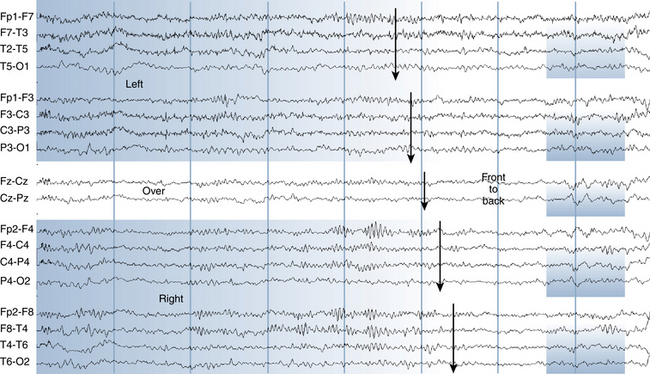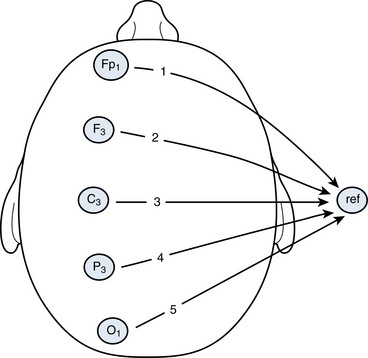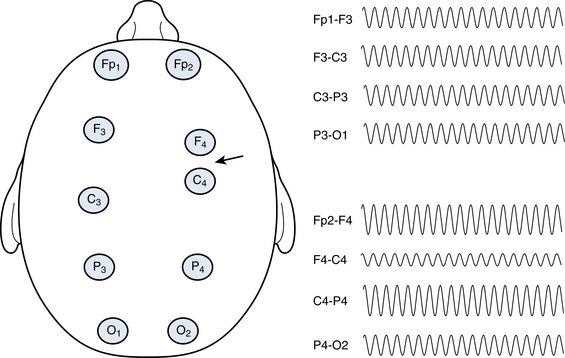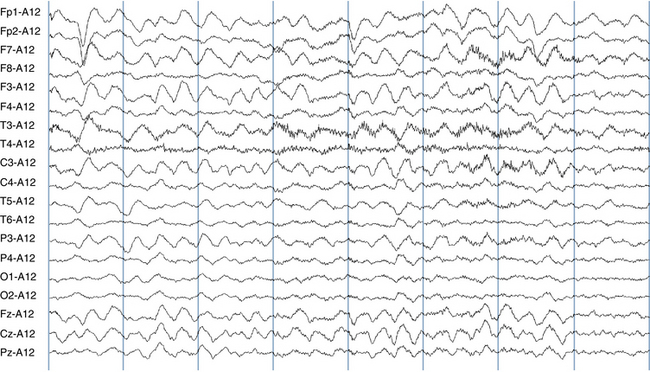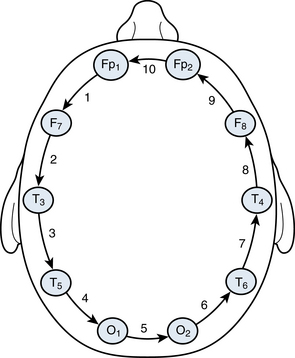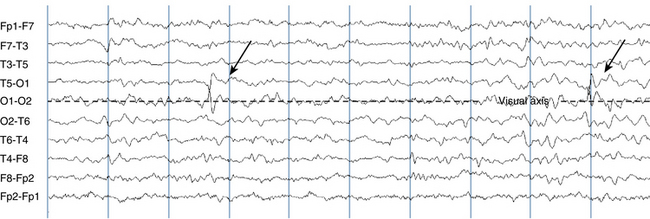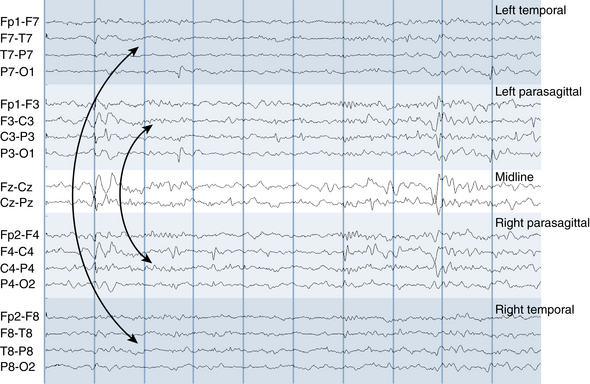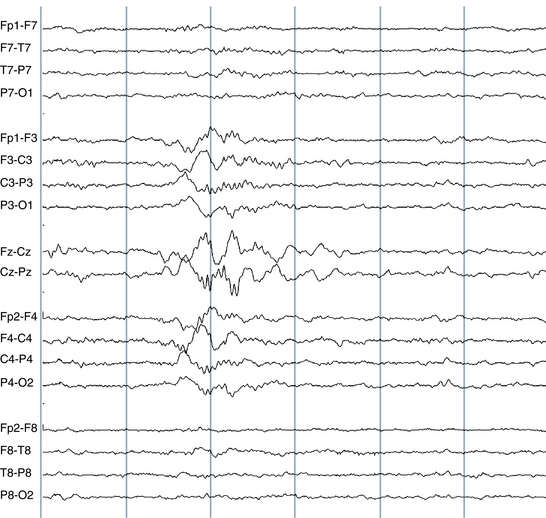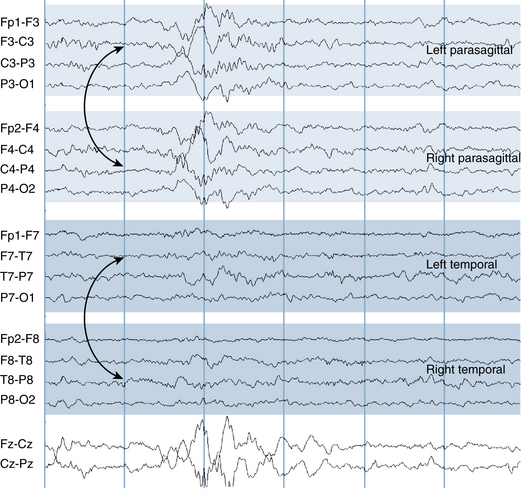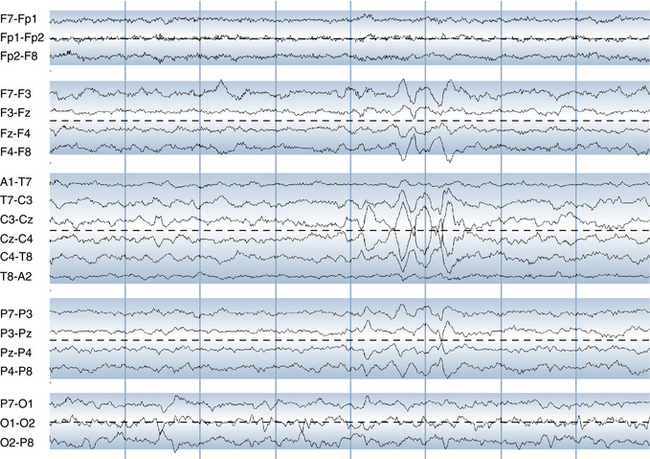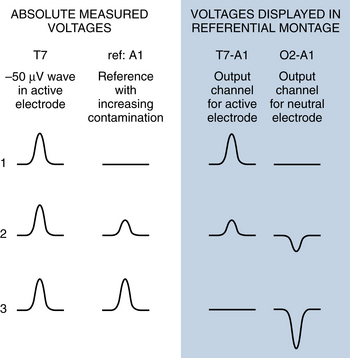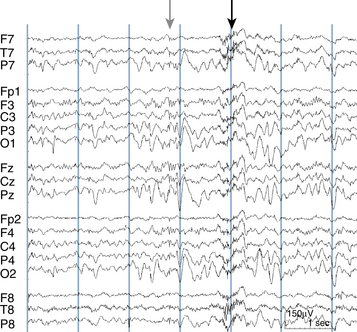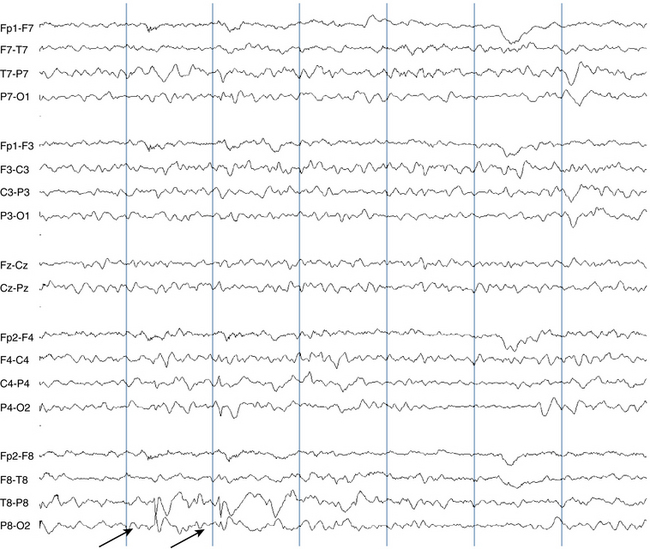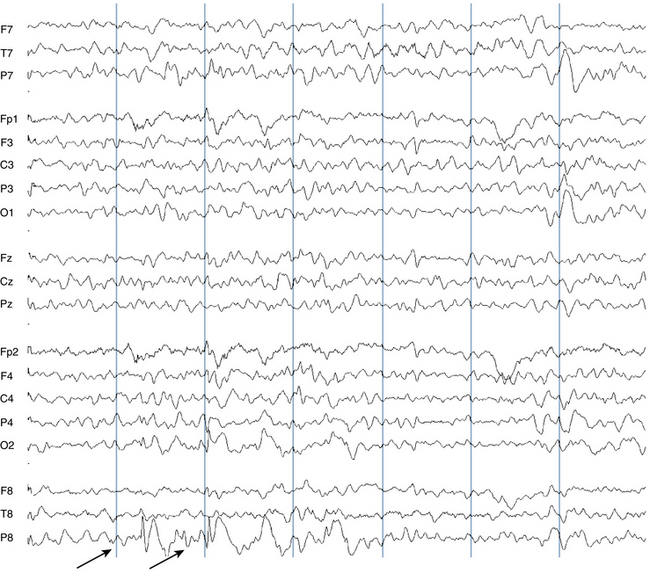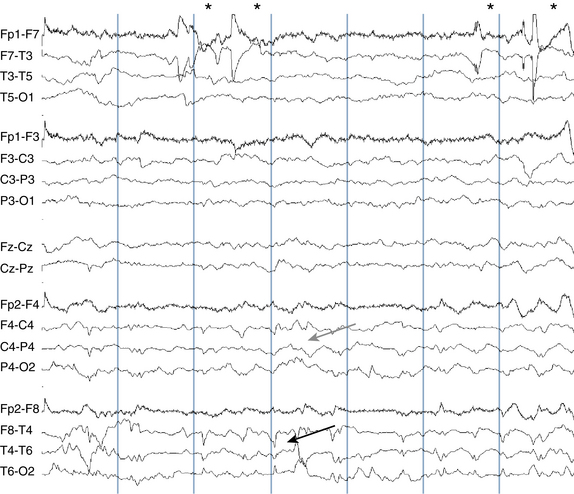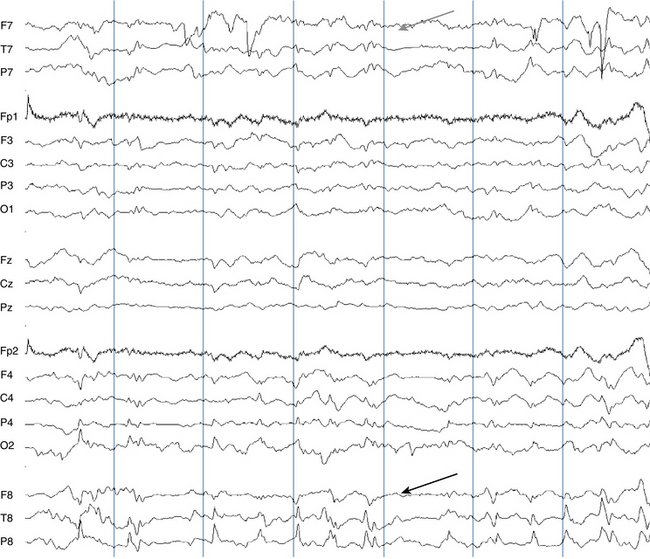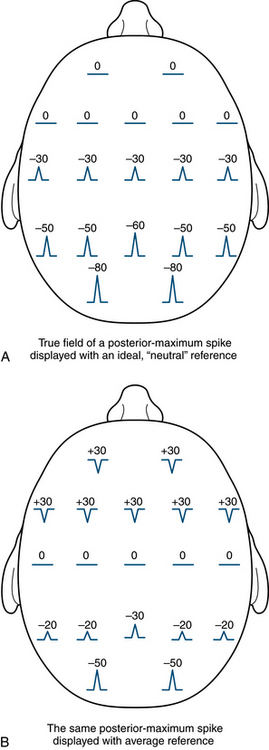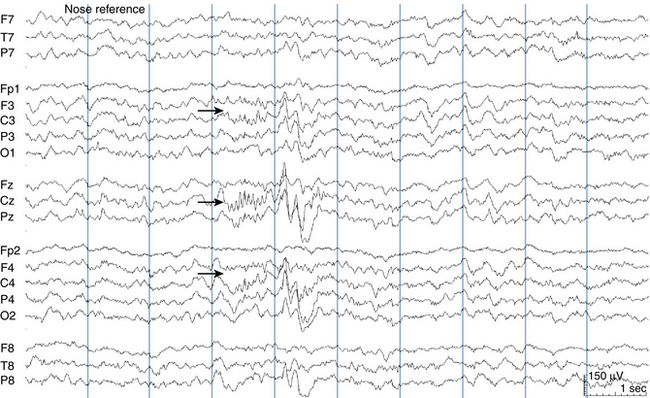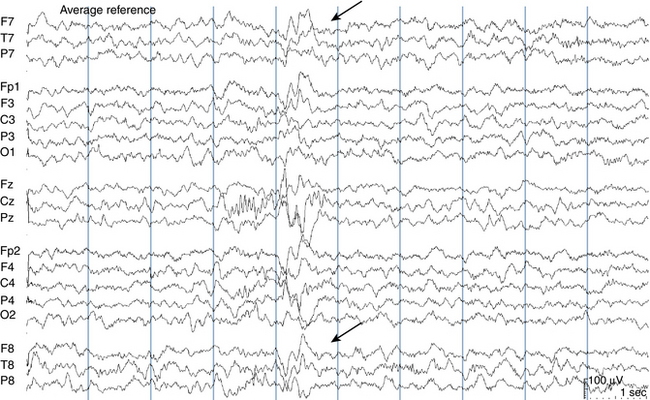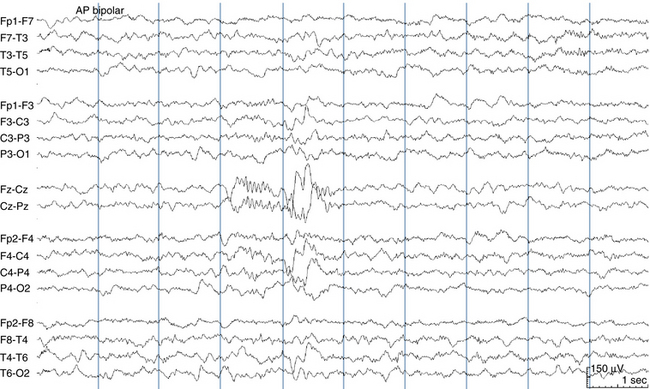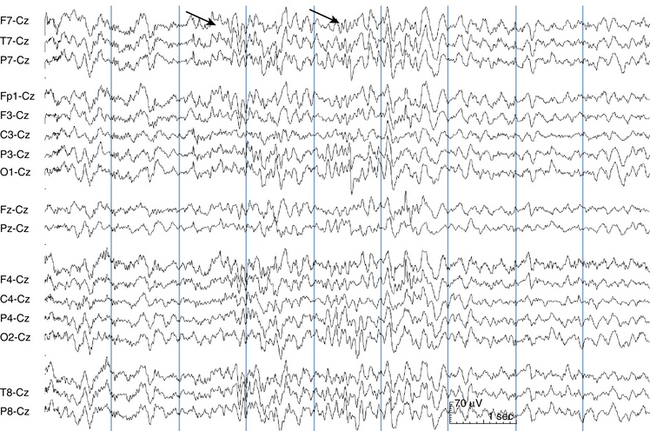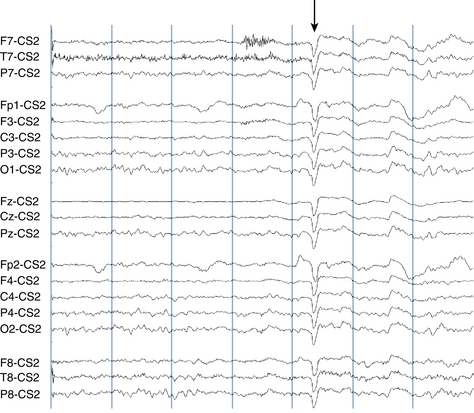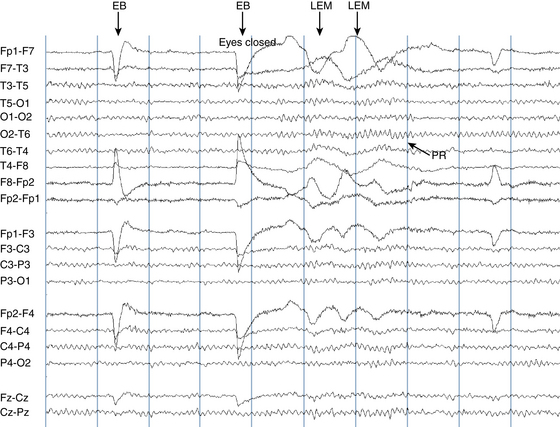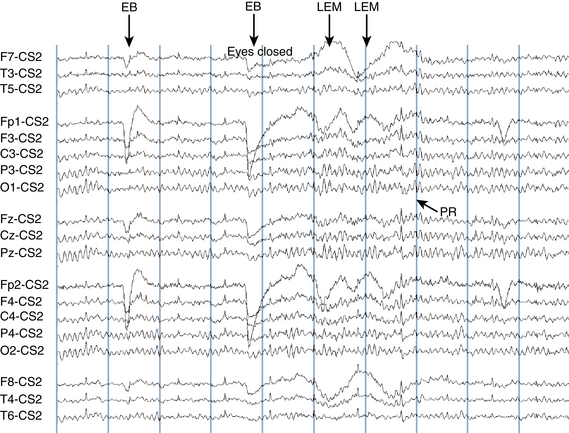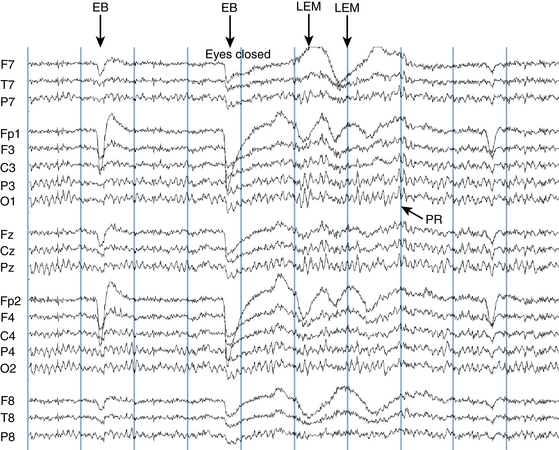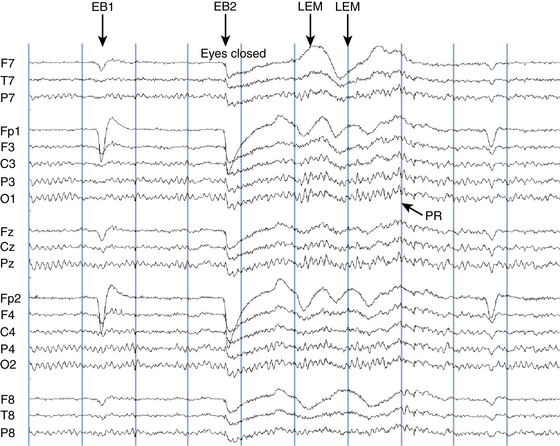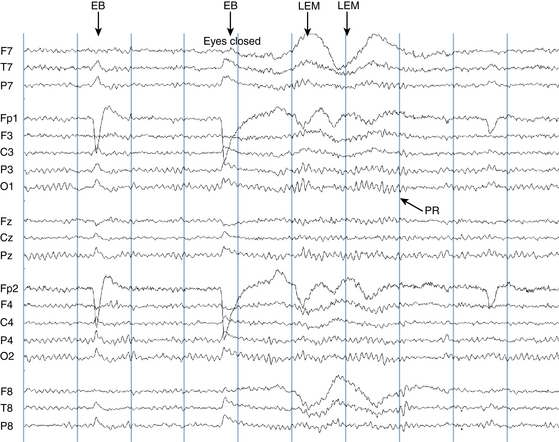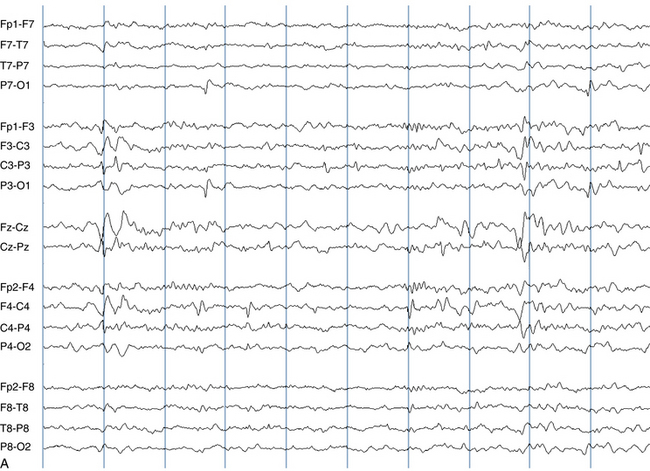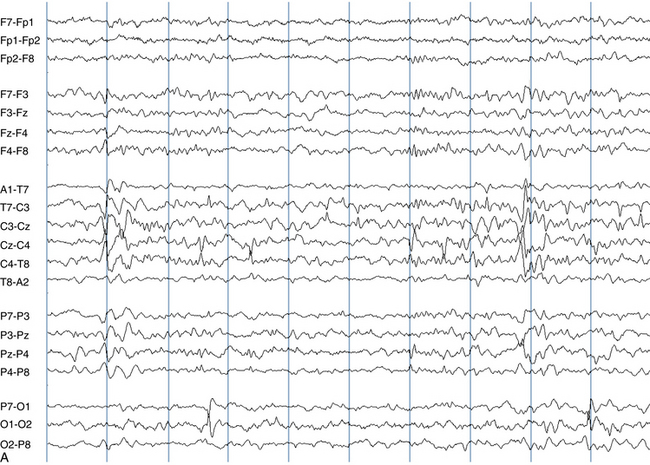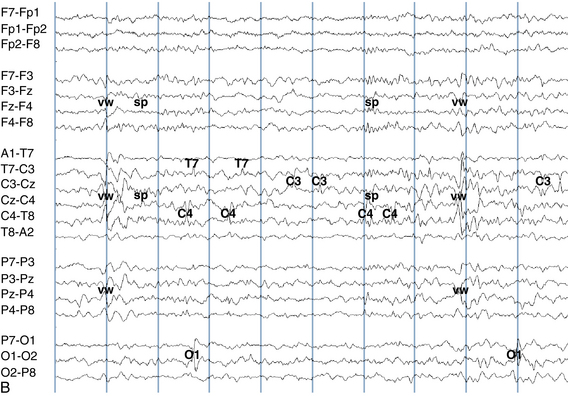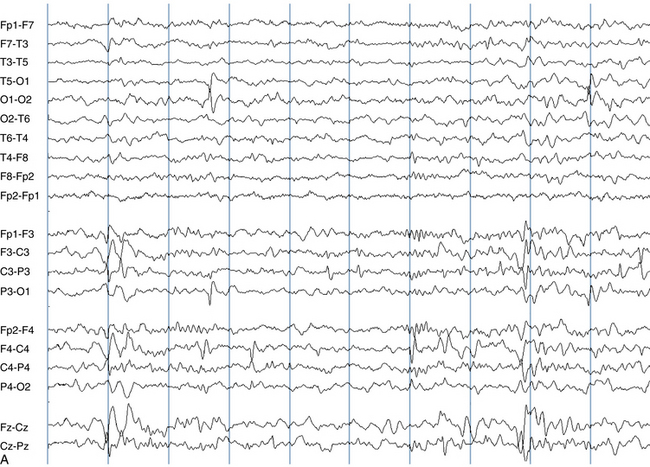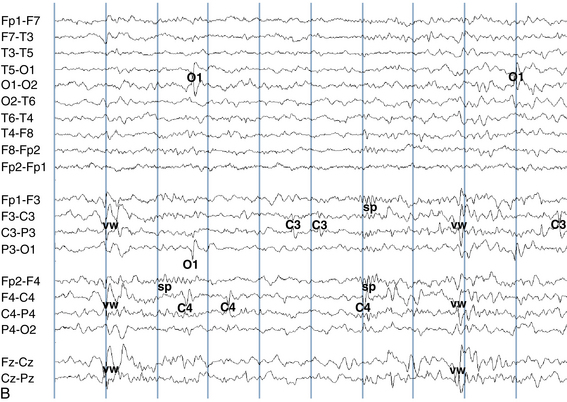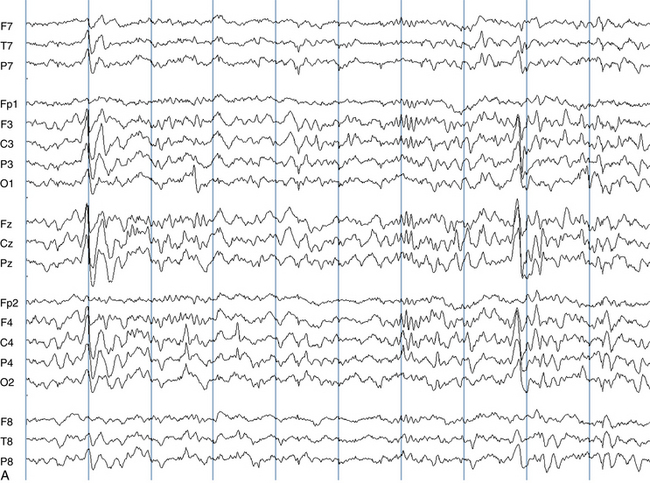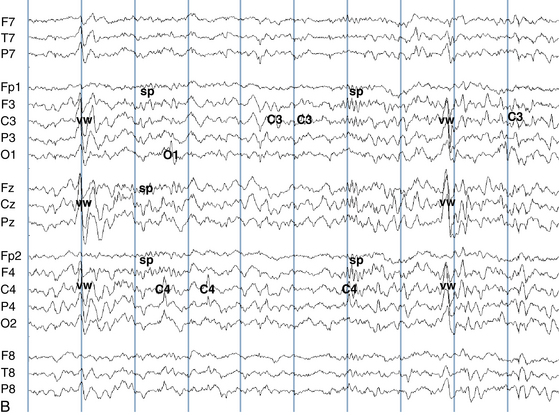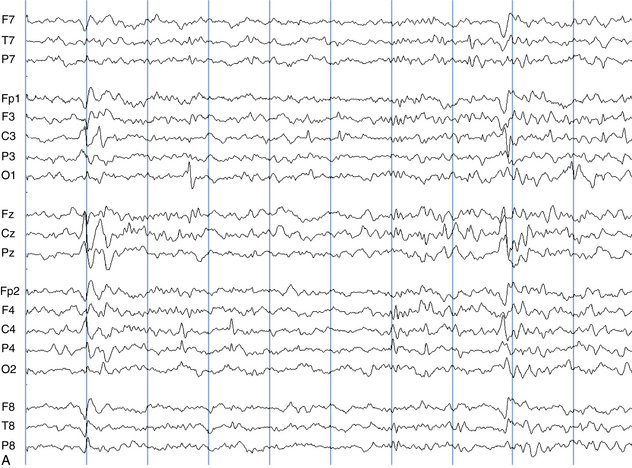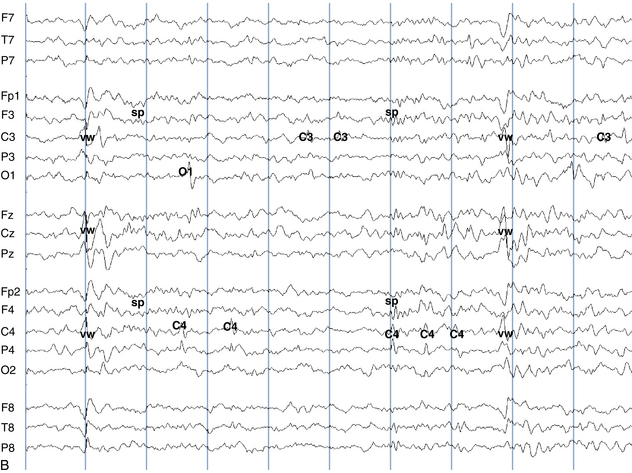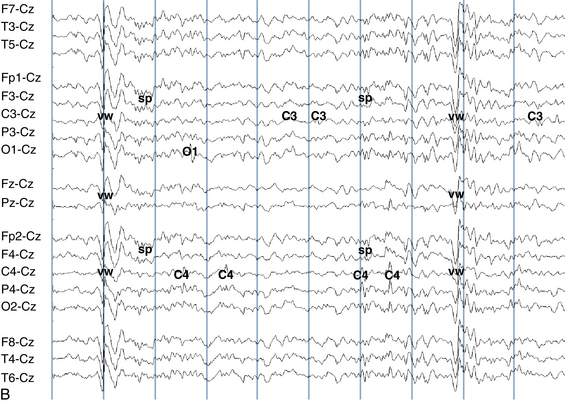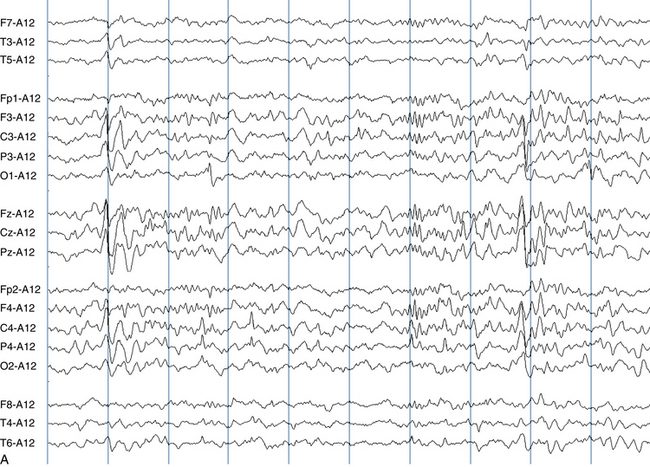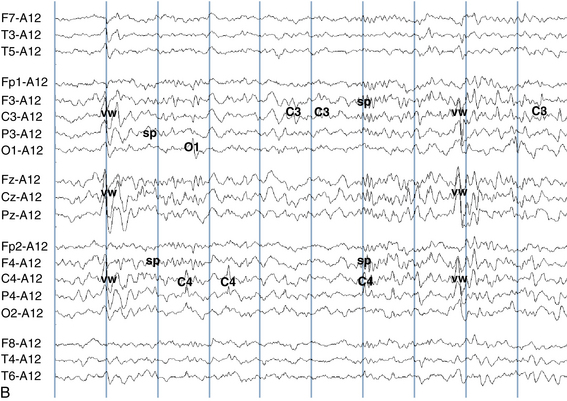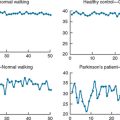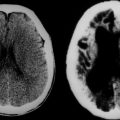Chapter 5 Electroencephalographic Electrodes, Channels, and Montages and How They Are Chosen
In addition to scalp electrodes placed to record brain electrical activity, additional “monitoring” electrodes may be placed on nonscalp areas to record other physiologic activities including heartbeat, respirations, eye movements, contraction of certain muscles, including the respiratory muscles, and limb movements. The schema for the placement and naming of the EEG electrodes according to the international 10-20 system was described in Chapter 3. While considering the strategies used in different montage designs, the reader should consider how montage choice affects the reading process and also how new montages might be designed in special situations. Such situations could include a patient in whom part of the head is not accessible for one reason or another (e.g., a surgical bandage) or the occasional patient in whom accurate localization requires the placement of intervening electrodes.
CATEGORIES OF MONTAGES: REFERENTIAL AND BIPOLAR
Montages are generally divided into two large groups, referential and bipolar, denoting the technique by which EEG data are displayed. Because there are significant differences in the strategies used by these two montage families, each is discussed in its own section. Localization techniques for each of these montage types were discussed Chapter 4.
Recommended Montage Conventions
Although electrode channels can be presented in any order when creating a montage, certain conventions are encouraged (see the American Clinical Neurophysiology Society [ACNS] Guidelines in References): channels should be placed in a “left over right” configuration (electrode chains from the left side of the head are placed nearer the top of the page, and chains from the right side of the head are placed nearer the bottom of the page). More anterior electrodes should be placed before more posterior electrodes (front-to-back ordering of channels going down the page is encouraged). Interelectrode distances should be consistent (electrode positions should not be unpredictably skipped in electrode chains). Finally, the design should favor the simplest arrangement possible (see Figure 5-1).
In the days of paper EEG recording, it was up to the EEG technologist to choose the montage that would best demonstrate the patient’s findings at any particular point in the tracing. If an EEG event happened to be recorded in a montage that was disadvantageous for interpretation, the ink had already dried on the page, and it was not possible to change settings retrospectively. The newer digital EEG technology presents a new set of problems. Although the same EEG page can be viewed in a variety of montages during the course of interpretation, some readers may find that it takes less energy to leave the display in one montage for the whole tracing, usually choosing the montage with which they are most comfortable. Although scanning a whole EEG study in a single montage may allow for faster reading, occasionally an EEG finding may be seen well in one montage but only poorly seen, or perhaps not seen at all, in another. It is therefore best practice for the EEG technologist or the reader to cycle through a minimum set of montages during the course of each study. This will usually include some combination of longitudinal bipolar, transverse bipolar, and referential montages.
MONTAGE DESIGN
Referential Versus Bipolar Montages
The term bipolar derives from the fact that, as can be seen from this chain, each channel represents the voltage difference between two “poles” on the scalp. Bipolar montages are occasionally referred to as differential montages because they display the difference between adjacent electrodes. Although the bipolar technique is a powerful recording technique and a favorite among many readers, bipolar montages also have their drawbacks, as discussed later. Figures 5-2 and 5-3 show a schematic of the difference between the referential and bipolar recording strategies.
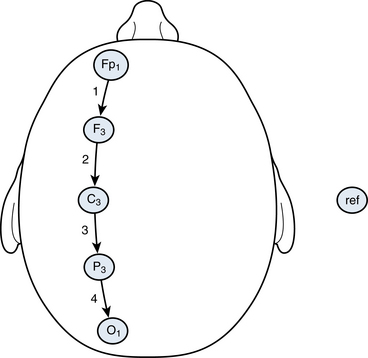
Figure 5-3 In this illustration, the same five parasagittal electrodes used in Figure 5-2 are connected to each other sequentially in a standard “bipolar chain.” Again, each arrow points from an Input 1 electrode to an Input 2 electrode creating the following montage: Fp1-F3, F3-F3, C3-P3, and P3-01. The reference position is not used. Each of the four channels generated with this technique represents the subtraction of an electrode from the previous electrode in the chain. Because the electrodes are paired to form each channel, five electrodes generate four channels of output.
Theoretical Strategies: How Can EEG Activity Best Be Recorded From a Single Point?
Recalling that our basic tool for creating an EEG channel is to print the amplified output of a voltmeter for which the needle sweeps one way or the other depending on the voltage difference between two points, there must always be two separate amplifier inputs, Input 1 and Input 2, to make a comparison. We decide to attach the “electrode of interest,” Fp1, to one pole of our voltmeter (Input 1), but what would be the most advantageous choice of electrode(s) to attach to Input 2, the comparison point? This comparison electrode is called the reference electrode, and serves as the reference point against which the electrode of interest is measured. As described in Chapter 4, the voltage measured from the reference will be subtracted from the voltage measured at Fp1, and the resulting difference is the output for the channel that we will label as Fp1-ref.
It is clear that the choice of the reference electrode could have as big an impact on the appearance of the resulting output trace as the Fp1 electrode. At first glance, the channel label “Fp1-ref” may seem to imply that its output represents the voltage at Fp1. Note, however, that the “active electrode,” Fp1, does not enjoy any privileged position by being attached to Input 1 as opposed to Input 2; the two voltages will simply be subtracted one from the other and displayed. For that reason, if the chosen reference electrode were the earlobe and there happened to be more electrical activity present in the earlobe than in Fp1, the output of an Fp1-earlobe channel would be dominated by the electrical activity in the earlobe—not the desired result. Clearly, the choice of the reference electrode in referential montages is important.
Choice of a Reference Electrode
Finally, consider the extreme example of moving the reference electrode so close to Fp1 that it is nearly in the same position as Fp1. In such an example, the signal in Fp1 and the reference are so similar that the difference output will become nearly flat. Some generalizations can then be made regarding the distance between the electrodes attached to Input 1 and Input 2 of a channel’s amplifier. When two electrodes are moved closer to one another, there is greater commonality between what each detects in terms of both the noise signal and the brain wave signal. Therefore, as two electrodes become closer to one another, a channel comparing them will flatten. Conversely, as interelectrode distances increase, there is a bigger difference in both the noise signal and the brain wave signal and the channel”s output signal tend to increase.
All things being equal, larger interelectrode distances are associated with higher voltages, and smaller interelectrode distances are associated with lower voltages. This effect explains the recommendation that electrodes should not be skipped in bipolar montage chains (or stated another way, that interelectrode distances should be held constant). A channel pair with an inconsistently large interelectrode distance will tend to produce a higher voltage channel, possibly giving the erroneous impression that there is more electrical activity at that location than at adjacent locations. Variation in interelectrode distances may occur in two ways: a montage design that skips an electrode or a significant mismeasurement of electrode position during electrode application (see Figure 5-4).
What would the ideal reference electrode location be?
Each potential reference location is prone to certain problems and advantages—no single reference electrode position is ideal for all patients at all times. For instance, the earlobes often share a portion of the electrocerebral activity present in the adjacent midtemporal areas, causing a cancellation effect. This makes an earlobe reference a poor choice for a patient with a high voltage midtemporal discharge. Also, the left earlobe in particular is often contaminated with EKG artifact because of the left-sided position of the heart. In some, the nose reference may be contaminated by a surprising amount of muscle artifact, whereas in others it can be fairly clean. The cervical area is contaminated by muscle artifact or EKG signal in some patients and may also be disturbed by movement when patients are lying on their backs. The midline vertex electrode, Cz, is usually free of muscle artifact because of its location at the vertex of the scalp but contains a large amount of electrocerebral activity, especially during sleep. In different individuals, any of these reference locations could generate satisfactory or unsatisfactory recordings at different times.
The main difference between the two systems, one of which alternates left- and right-sided electrodes and the other of which groups left-sided electrodes in one area and right-sided electrodes in another, is the comparative ease of visual scanning for asymmetries. Choice of one of these arrangements over the other is essentially a matter of preference. Figures 5-5 and 5-6 show examples of dramatic left-sided slowing displayed with each of these two common strategies. The latter system, which groups electrodes together by location, is seen to have certain advantages. Asymmetries that occur between hemispheres are not usually localized to a single electrode but to a regional group of electrodes. For instance, if a temporal slow wave is present, it may be recorded in multiple electrodes such as F7, T7, and P7. When an abnormality such as a spike or a slow wave is present in multiple adjacent channels on a page, it tends to be easier to identify visually when the spatial clustering system is used. In the alternating left–right setup, the abnormality will only be seen in alternating channels. Another advantage of the clustering system is the ease of visualizing the topography of the discharge on the scalp; with this system a region of the page corresponds to a region of the brain starting with the fact that the left hemisphere is represented on the top of the page and the right hemisphere is on the bottom. Grouping the channels by region, especially when gaps are used between electrode groups as in the example illustrated here, makes it simple to know where a given channel is on the head at a glance, even without reading the channel labels. In contrast, when reading in a montage in which the left and right channels are alternated, it can be difficult to know the location of each electrode without consulting the channel labels. Proponents of the left–right alternating system like the fact that homologous channels are adjacent to one another, making individual interchannel comparisons easier. Considering these reasons together, the author prefers the clustering system (left over right and front to back), which should allow for easier and more accurate scanning and spatial visualization for most readers. However, the choice of either of these two arrangements is really a matter of laboratory or reader preference.
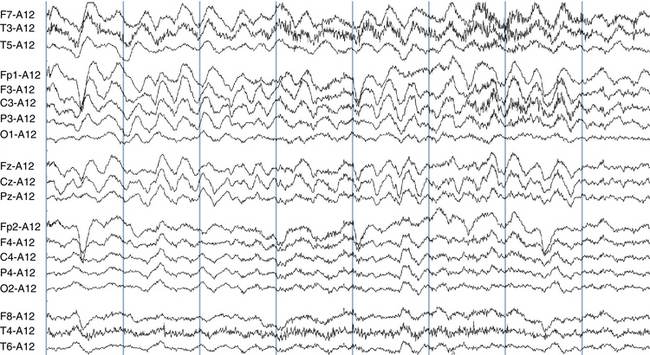
Figure 5-6 This EEG page shows the exact same left-sided slowing as was seen in the previous figure, however, the channels are ordered in chains so that the left hemisphere electrodes are shown on the top half of the page and the right hemisphere electrodes on the bottom. Starting at the top, channels are grouped on the page as the left temporal, left parasagittal, midline, right parasagittal, and right temporal chains (see channel labels). The same reference is used as in the previous figure, an average of the A1 and A2 electrodes. Note that, with nearby electrodes grouped together, it is visually much easier to appreciate the localization of the slowing over the left side of the brain (top half of the page). For this reason, this arrangement is favored by the author.
Categories of Bipolar Montages
There are two principal categories of bipolar montages, the anteroposterior (AP) bipolar montage and the transverse bipolar montage. The two types differ in that, with AP bipolar montages, electrode chains run from front to back (anteroposteriorly) down the head, and in transverse bipolar montages, the chains run from left to right (transversely) across the head. The fact that the reader has both of these montage families available for use raises the question of whether any particular discharge might only be visible in the AP bipolar but not in the transverse bipolar montage, or vice versa. Is it really necessary to use both AP and transverse bipolar montages for EEG interpretation, and, if so, what would be lost by not doing so?
Circumferential Montages
Some laboratories also use a third ordering for bipolar electrode chains, one that makes a complete circumference around the head (see Figure 5-7). This style of montage has been given a variety of names, such as a halo, circumferential, or hatband montage. Close examination of the electrode pairs used in the circumferential montages shows that almost every pairing is also present in the standard AP bipolar montage. The only electrode pairings that are unique to circumferential compared with AP bipolar montages are the Fp1-Fp2 and O1-O2 pairs. Because these two pairs are included in the transverse bipolar montages, circumferential montages are not a mandatory member of a laboratory montage set, although the decision to use such a montage is at the discretion of the electroencephalographer. For this reason, the use of a minimum of three montages—AP bipolar, transverse bipolar, and referential—is usually adequate to cover all necessary electrode pairings in standard EEG recording. Circumferential montages, when used, lend themselves to a particular technique for visual scanning. A visual axis is chosen and surrounding channel “layers” are compared (see Figures 5-8 and 5-9).
Disadvantages of the Bipolar (Differential) Technique
At first glance, if the bipolar montage recording system were as poor as the temperature reporting system given in this example in which we could not tell a hot day from a cold day, how is it that bipolar montages are useful at all? The answer is that, when we read an EEG page, we make an implicit assumption that the average baseline of everything that we see printed out is near neutral voltage (or “zero”). Indeed, because of the laws of electricity and charge, it is quite unlikely that all scalp areas will be either strongly negative or strongly positive for a prolonged period of time. Therefore, as we read, we are making a subconscious assumption that the average of everything that we see on the page is near zero. Nevertheless, we do lose absolute voltage information. We cannot know whether certain events may be slightly positive or slightly negative just by looking at the bipolar montage; we can only assert that an event is, for instance, “more negative” than the areas around it. For this reason, absolute measurements of voltage cannot be made as easily as they can be in a referential montage or, if they are made, they mean something different. When a reference electrode is used, we are making the implicit assumption for the purposes of measurement that the voltage at that electrode is neutral or zero (although we might shy away from making this assumption at a time that there is clearly a lot of noise in the reference electrode). This assumption is shakier when made in a bipolar montage, a system in which we only see voltage differences between nearby points on the scalp rather than absolute voltage measurements.
An extension of the problem of not knowing the absolute magnitude of the voltage at any given point when reading in a bipolar montage is the tendency for cancellation of like activity in adjacent electrodes. Here, again, we can imagine a case in which there is a posterior slow wave more or less equally represented in the three posterior electrodes: C3, P3, and O1. In such an example, when recording with a bipolar montage, this posterior slow wave could cancel itself out to a large extent in the areas where it is at highest voltage, simply because it happens to be equally represented between the pairs of electrodes being compared (e.g., C3-P3 and P3-O1). This effect is illustrated in Figure 5-10. This effect does not occur in referential montages.
This is one of the main disadvantages of bipolar recordings—that adjacent, in-phase activity tends to cancel out. This can cause a paradoxical effect: disappearance of a wave in an area where its voltage is highest and appearance of that wave only when a chain moves into an area where it begins to disappear. It is in the comparison of the area where the wave is present to the area where it disappears that the “difference” is picked up by the bipolar recording technique, not necessarily the area in which the voltage is highest. Some of these effects are also illustrated in the exercises in Chapter 4 on localization. Fortunately, in practice this effect is not as big a problem as it might seem to be, because like activity in adjacent electrodes is often out of phase (not perfectly lined up with the wave in the adjacent electrode) and therefore does appear in the “correct” location in bipolar montages after subtraction. Still, it is wise to confirm a mild voltage asymmetry noted in a bipolar montage by reexamining it in a referential montage to exclude this potential shortcoming of bipolar recordings.
Techniques for Visual Scanning of Montages
AP Bipolar Montages
After you are familiar with the montage set used by your laboratory, it is useful to develop a visual scanning strategy for each montage in the set, a visual method or thought process for looking at each page of EEG that allows quick determination of interhemispheric or anterior versus posterior asymmetries. The first example we will look at is the standard AP bipolar montage used most frequently in the examples in this book. This AP bipolar montage conforms to the conventions suggested by the American Clinical Neurophysiology Society (ACNS) in that it uses the left-over-right and front-to-back conventions. Figure 5-11 uses shading to demonstrate the technique for detecting asymmetries. An axis should be imagined through the two midline channels, which have been left unshaded and represent the cranial midline. Next, the two inner (parasagittal) chains, which are lightly shaded in blue, should be compared. Is there more slow activity or fast activity in one light blue area compared with the other light blue area? If so, a parasagittal asymmetry is likely. Similarly, is there an asymmetry of activity between the more darkly shaded outer (temporal) chains? If so, a temporal asymmetry may be present.
Other laboratories may use the left parasagittal/right parasagittal/left temporal/right temporal ordering for the AP bipolar electrode chains. If so, the scanning strategy is adjusted accordingly. Figures 5-12 and 5-13 show a comparison of the two most common arrangements for the AP bipolar montage. Neither is technically superior to the other because both include the exact same set of channels, simply presented in a different order, and each will be commonly encountered in different laboratories.
Transverse Bipolar Montages
The transverse bipolar montage can be scanned in a fashion that is somewhat similar. Again, note the shading of each group shown in Figure 5-14. In this text, most illustrations of the transverse bipolar montage include a white space (a “gap”) inserted between each chain, making it visually simpler to scan, although the practice of inserting these gaps is not common to all laboratories. Gaps make it easier to see the groupings of individual electrode chains, but they sacrifice space on the page and therefore diminish the amount of line height that can be assigned to display each channel. The dashed lines in the figure suggests the axis around which each electrode chain should be visually scanned. If channels look different in the area above the axis compared with the area below it, this suggests a difference in that chain between the left and the right sides of the brain. The reader should practice visualizing the superimposition of this shading on the page to help quickly determine which part of the page corresponds to which part of the brain.
Referential Montages
Scanning referential montages that use the alternative method of left–right channel pairings is fairly straightforward in that odd channels are left-sided and even channels are right-sided, but there is no simple method for picking a line on the page and quickly ascertaining the area that that channel corresponds to on the brain surface without referring to the channel labels. This is the advantage of the second system of electrode ordering for referential montages, which mimics the ordering used for AP bipolar montages: the brain location of any channel can be easily ascertained based on its position in the clusters of channels on the page.
Montages for Special Situations
Regarding the use of additional electrodes, the most common “extra” locations added are the T1 and T2 electrode positions, which are designed to record from the anterior temporal lobe. The T1 and T2 names represent old nomenclature and correspond approximately to the FT9 and FT10 electrode positions of the modified 10-10 electrode system. A variety of methods can be used to incorporate these additional electrodes into a display montage. An example montage is shown in Figure 5-15. Use of these special temporal electrodes has to a great extent supplanted the use of more invasive electrodes, such as sphenoidal and pharyngeal electrodes.
The Choice of the Reference Electrode (Revisited): “More Important Than It Seems”
Figure 5-16 shows examples of the first two situations and illustrates the effects of increasing spillover or contamination of the reference electrode (in this case, the left earlobe) of a discharge picked up by T7 (the left midtemporal electrode). It also shows the potential pitfalls of using the earlobe reference to display the activity at a distant, inactive location such as O2 (the right occipital electrode) when there is contamination of the reference. Because the discharge does not involve O2, the reader would expect that the O2 channel will be flat, but this is not the case when an earlobe reference (A1) that is contaminated with an active discharge is used in a channel (O2-A1) to display O2 activity. This is a realistic example because the ipsilateral earlobe often does have brain wave activity in common with the left midtemporal area. An example of a third type of situation in which unrelated noise contaminates the reference electrode is shown in Figure 5-17.
The Average Reference: Strengths and Weaknesses
When reading an EEG tracing in an average reference montage, a good strategy is to estimate what the average reference signal should look like at any moment. Considering all the channels together, the average reference can be visually estimated by mentally summing up the voltages of all the channels, noting the relative strength of upgoing waves compared with downgoing waves and predicting the average. It is clear that when the various channels are of low voltage and there is not much activity, the average reference, too, will be of low voltage and relatively neutral. At such times, the average reference generally gives a very clean and useful comparison. What happens, though, when there is a lot of activity in the EEG? In the case of a very focal spike, when it is averaged among the large number of inactive electrodes, that spike’s voltage becomes diluted significantly when averaged with the quiet electrodes and may have little visible effect on the average. What if the spike is present in several electrodes, or what if the spike is of particularly high voltage? As an electrical scalp event rises in voltage or is present in an increasing number of electrodes, it will clearly affect the average reference to an increasing degree. When discharges on the scalp make the average reference “active,” it is important to remember that this activity will now be subtracted from every “electrode of interest” in the montage.
Consider the simple example of a 20-electrode set, and, at one point, the reader notes that two of the channels measure −100 μV and the other 18 channels are flat (0 μV). The value of the average reference electrode at that time will be (−100 + −100) / 20 or −10 μV. The two electrodes that are active with the −100 μV spike will be compared with the −10 μV reference (−100 μV minus −10 μV = −90 μV) and display a −90 μV (upward) deflection, which is a satisfactory approximation of the true −100 μV spike. The same subtraction also takes place, though, for each of the inactive electrodes so that any inactive electrode’s channel when compared with this average reference will show a small positive (downward) deflection of 10 μV, even though these electrodes are, in reality, neutral (Input 1 electrode equals zero and Input 2 electrode equals −10; Input 1 − Input 2 = +10 μV). This small amount of deflection may be tolerable, especially if it is expected by the alert reader who predicts that the average reference will be mildly negative at that moment on the basis of observation of all of the channels. A reader who does not take this effect into account could erroneously conclude that there is a low-voltage concurrent positive spike occurring broadly across the brain, which is not the case.
Figures 5-18 and 5-19 show an example of an effective use of the average reference. In this example, a spike in P8 is so focal that it does not contaminate the average reference to any significant extent and the average reference montage displays an excellent representation of the field of the spike. Figure 5-20 shows an example of a seizure discharge with a broad field across the right hemisphere that is clearly restricted to the right side of the brain, displayed in a bipolar montage. Considering what this discharge might look like if displayed in an average reference montage, the alert reader will note that the discharge involves many electrodes and would thus be expected to be visible in the average reference. Figure 5-21 shows the same page displayed in an average reference montage. Because the average reference is contaminated with the discharge, as expected, this montage gives the false impression that the seizure discharge is present on both sides of the brain.
A schematic of an idealized posterior-maximum spike is shown along with numerical voltages in Figure 5-22 to illustrate the mathematics behind contamination of the average reference. The top half of the figure shows the “true” discharge, and the bottom half shows what the display will look like if an average reference montage is used. A reader who only sees the bottom display and who does not understand average reference montages may not appreciate that the discharge represents a simple negative spike involving only the posterior half of the brain.
The average reference can be contaminated by nearly any type of EEG activity, not just by abnormal discharges. In some patients, normal activity such as vertex waves of sleep and sleep spindles are of high enough voltage and have a broad enough field they will affect all channels of an average reference montage, clearly an undesirable effect. Figures 5-23 and 5-24 show how even normal sleep activity can make a montage that uses the average reference confusing to interpret. Figure 5-25 shows the same page of EEG in an AP bipolar montage for comparison. The montage that uses the nose reference clearly shows the vertex waves and spindles in their proper locations, the midline and parasagittal areas; these waves are much less evident in the temporal chains. Because the spindles and vertex waves are widespread enough to contaminate the average reference, the average reference montage gives the mistaken impression that the field of the spindles and vertex waves extends strongly into the temporal areas, which it does not.
Detecting Contamination in the Average Reference Electrode
Taking this phenomenon into account provides an effective technique by which to detect whether and in what way the average reference electrode is contaminated. The reader can seek out an electrode position that is assumed to be neutral and examine the channel from the presumed inactive location. For example, if there is strong suggestion that a discharge is coming from the left frontal area, the reader may wish to examine the channel representing the distant right occipital region and assume that it is neutral. If the channel that compares that neutral electrode to the average reference shows the discharge, but with its phase reversed or “flipped,” this strongly suggests that the reference is contaminated, as was shown in the bottom half of Figure 5-22. Therefore, when using an average reference montage, just because a deflection is seen across all channels, the reader should not simply conclude that the discharge is present in all those channels; rather, the possibility that the reference is contaminated must be considered, especially when the discharge’s polarity appears to be reversed in several channels.
This line of reasoning can also be extended to the use of a standard (nonaveraged) reference electrode and is useful when the reference is close to the vicinity of the discharge and actually records a portion of that discharge. In such cases, the discharge should be seen in the channels that include active electrodes, but it will be somewhat attenuated; some of the discharge will be “subtracted away” because the reference electrode is also active. Again, and similar to what was described in the previous paragraph for the average reference, when the activity in the reference is subtracted from channels with neutral electrodes, a “flipped” version of the discharge appears in those locations in what can initially be a misleading, but ultimately informative fashion. Note that the effect of the “flipped” discharge also served as a clue to contamination of the average reference in Figure 5-21.
A related and dramatic version of the problem of the contaminated reference is seen in referential montages when the Cz electrode is chosen as the reference. In good electroencephalography laboratories, Cz is almost never chosen as the reference electrode for the referential montage. Very occasionally, however, Cz is the only available choice in a very active patient because there is no scalp muscle to generate muscle artifact under this midline electrode. Using a Cz reference can help avoid contamination with muscle artifact, but what happens when the patient falls asleep? Sleep vertex wave activity is maximally represented in the Cz electrode, and spindle activity is also plentiful there. For this reason, the sleeping patient in whom a Cz reference is used will manifest vertex waves and spindles in every channel (see Figure 5-26). Such a tracing can be difficult to interpret and is essentially unsatisfactory for most purposes.
The second simple technique that can allow quick visual exclusion of a wave that arises from a contaminated reference is the phenomenon of a wave or signal that shows the exact same morphology in every channel. Higher voltage contamination will tend to have an identical appearance in all channels because that signal has been subtracted from each channel’s output. Figure 5-27 shows an example of such easily identifiable contamination.
The Laplacian Reference
While use of the Laplacian reference can produce some satisfactory recordings, there is a fundamental disadvantage to this technique. As stated earlier, a basic tenet of careful interpretation of a referential montage is the importance of always knowing the exact reference in use. The problem with the Laplacian reference is that the question of “what is the reference?” is a constantly moving target because for every scalp electrode the reference is different. The fact that each electrode has a different reference may either slow down the analytic process of EEG interpretation or give the reader the incentive not to consider what the true reference is for every given channel, possibly leading to sloppy interpretation of complex electrical events. For these reasons, some feel that the Laplacian reference contributes little in the way of advantages over the average reference but presents a specific disadvantage to a reader who appropriately needs to know the composition of the reference for all channels at all times.
The Appearance of Standard EEG Features in Different Montages
Figure 5-28 shows the typical appearance of eyeblink artifact in the AP bipolar montage. Because eyeblink artifact is caused by a large transient positivity in Fp1 and Fp2, the abrupt, downward-sloping waveforms seen in the four most anterior channels are characteristic for eyeblink artifact. The opposing phases seen in the anterior channels after the second eyeblink artifact are typical for lateral eye movements (see the figure caption for further explanation). In this figure, the posterior rhythm is seen in the posterior channels and even reaches as for forward as the F3-C3 and F4-C4 channels. Does this imply that the posterior rhythm is actually present in C3 and C4? The answer is no—the posterior rhythm is seen in F3-C3 because it disappears between F3 and C3. Because the two channels differ in that C3 picks up the posterior rhythm and F3 does not, the subtraction of the two channels still displays the posterior rhythm’s waveform.
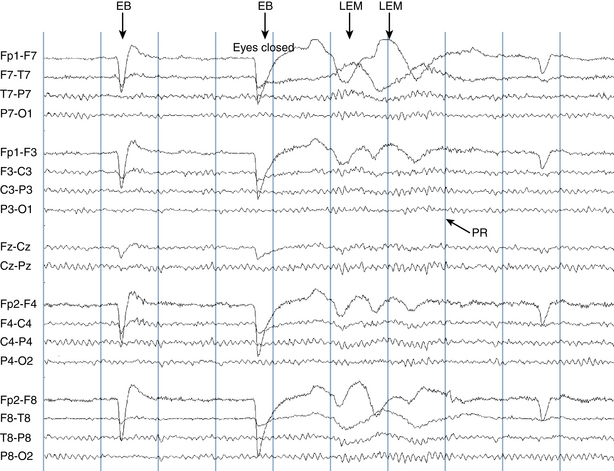
Figure 5-28 A page of wakefulness is shown in the anteroposterior (AP) bipolar montage. Eyeblink (EB) artifacts are the most prominent waveforms in this awake tracing, seen as a dramatic downward deflection most prominent in the top channel of each grouping of four channels in the AP bipolar montage. A smaller but similar deflection is also seen in the first channel of the midline electrodes (Fz-Cz). Eyeblink artifact is caused by an upward bobbing of the eyes that reflexively occurs during eye closure (Bell’s phenomenon). Because the anterior aspect of the eye is positively charged with respect to the posterior pole, eyeblinks result in a net positivity being detected by the frontal electrodes. Because the gradient (voltage difference) is typically greatest for eyeblink artifact between the most anterior electrodes (Fp1 and Fp2) and those directly posterior to them (F7, F3, F4, and F8), the eyeblink artifact waveform is almost always of highest amplitude in the most anterior channels (e.g., Fp1-F3 and Fp2-F4), as seen in this figure. Typically, this artifact is also visible, but to a lesser extent, in the next more posterior channels (e.g., F3-C3 and F4-C4). Because of the anterior source of the eyeblink potential, it is unusual to see a deflection posterior to these channels. Indeed, as is seen in this figure, the eyeblink deflection is not picked up in channels such as C3-P3 or T8-P8. At the end of the sixth second, high-voltage waveforms show opposing phases on the left compared with the right (lateral eye movement [LEM]). This type of artifact is caused by lateral eye movements and is discussed in more detail in Chapter 6. PR = posterior rhythm.
This same EEG page is shown in a variety of montages in Figures 5-29 through 5-35. It is worthwhile to take the time to identify each of the main elements of the awake EEG in each of these montages.

Figure 5-29 The same page of wakefulness as in Figure 5-28 is shown in the transverse bipolar montage. The eyeblink (EB) artifact is now essentially confined to the top three channels. Because the upward movement of the globes, which represents a net positive charge, is detected equally in Fp1 and Fp2, the amount of deflection in the Fp1-Fp2 channel is small. The Fp1 and Fp2 electrodes are, however, closer to the positivity of the eyeball as it bobs upward than the F7 and F8 electrodes. For this reason, the net positivity picked up by Fp1 being greater than at F7, the first channel, F7-Fp1, deflects upward. Likewise, because Fp2 detects more positivity than the F8 electrode, the third, Fp2-F8 channel, deflects downward. The posterior rhythm (PR) is well seen in the bottom three channels as expected, and also in the previous four channels, which link the left and right posterior temporal areas together, and even in the chain that links the left earlobe to the right earlobe (middle group of six channels). Only occasional fragments of the posterior rhythm are picked up in the chain that links the anterior temporal electrodes, F7 and F8 (the fourth through seventh channels nearer the top of the page). LEM = lateral eye movement.
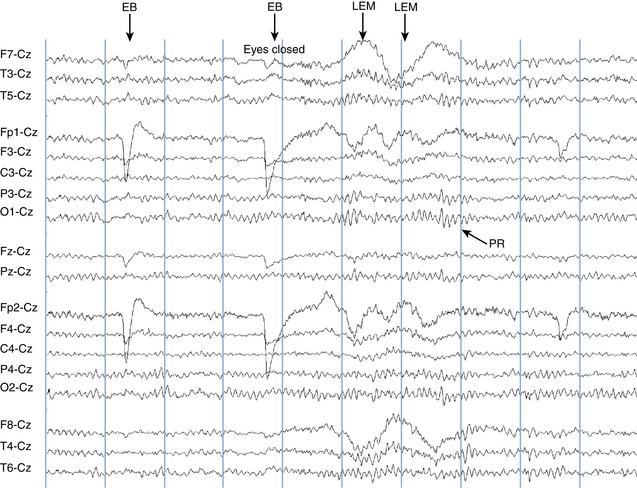
Figure 5-35 A page of wakefulness is shown in the anteroposterior referential montage using Cz as the reference. In this patient at this time in the tracing, the Cz electrode is relatively quiet. For this reason, this page appears to be of generally good quality, though note that the posterior rhythm can often be seen in all channels on the page, reflecting the fact that Cz is close enough to the back of the head that it intermittently picks up the posterior rhythm. This can be confirmed by looking at Figure 5-33 in which the posterior rhythm can often be discerned in the Cz-nose channel. Because all channels on this page are being compared to Cz, any activity that occurs in Cz has the potential to appear on every channel of the page. EB = eyeblink, LEM = lateral eye movement, PR = posterior rhythm.
Figures 5-36 through 5-42 show the appearance of vertex waves, sleep spindles, and focal spikes from the same page of EEG recorded during sleep in the various montages (see figure captions for additional description). The top half of the figures show the EEG without markings to allow the reader to practice identifying key features. The bottom panel shows the same page with an “answer key” superimposed.

